转换生成语法PPT
转换生成语法

——转换生成语法
转换生成语法
一、代表人物
二、含义
三、语言结构的转换规则
四、语法研究的主要内容
五、意义与局限
Noam CHOMSKKY’THEORY
——诺姆.乔姆斯基
•诺姆.乔姆斯基是当代最著名的语言学家,也是美国著名的政治评论家,曾被哲学界誉为历史上影响最为重大的5位思想家之一。如今是美国科学院院士,美国文理科学院院士,美国政治科学院院士,英国皇家科学院通讯院士。
二、局限
乔姆斯基语言学观点在哲学上的错误在于把感性认识与理性认识的关系割裂开来,片面夸大理性认识的作用。把语言分为深层结构和表层结构就是这种割裂所引起的。
3.乔姆斯基的“转换”不单是一种平行的变换,更为重要的是一种深层形式到表层形式的生成过程。是把现代音位学的“位”观念引申到语句结构中的必然结果。
4.“转换”体现的是生成语法学“规则系统”阶段的特点,带有个别语法的性质。
生成
一、创造性
这时就语言本身的客观属性来说的。任何一种具体语言都有很高程度上的递归特点,即“有限手段的无限运用”。具体说,外在化的语言是个无限的句子集合,但内在性语言却表现为一套数量有限的规则,语言的创造性就表现为以有限的规则生成无限数量的合格的句子。
语法转换部分表层结构语音部分句子的语音表现
基础部分深层结构(指向转换部分)语义部分句子的语义表现
意义与局限
一、意义
1.从语言本身来看,我们必须承认对语言结构的研究不完全是形式化的,也是实质性的,它对语言认识的深入,标志着语言学的发展。
2.任何事物都存在着结构,语言也不例外。结构主义者认为语言存在着二元结构,在索绪尔哪里是能指和所指的结构关系,在乔姆斯基那里是深层与表层结构的关系,认识语言就是要认识他的结构。这对我们理解语言的深层含义和表层含义具有重要启示作用,同时影响着结构主义者关于不同结构的划分理论。
转化生成语法
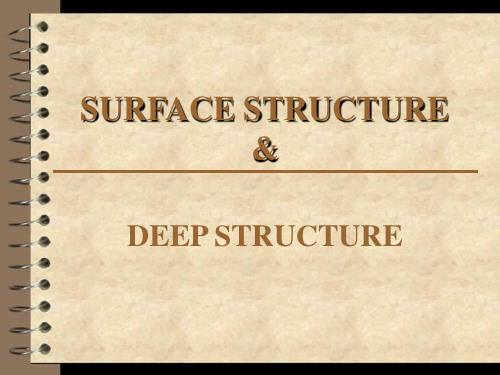
The deep structure shows the semantic components but the surface structure shows the proper phonological information in order to express that thought.
Common Transformational Rules
deletion删除
The cat disappeared and the dog disappeared → The cat and the dog disappeared
copying复制 addition增添
Get out!→ Get out of here!
Model
Deep Structure ⇒ Semantics by Transformations Surface Structure ⇒ Sound This is the model assumed in Cartesian Linguistics.
The cat killed the bird → the bird was killed by the cat. The bird was killed. The killing of the bird (by the cat). The cat’s killing of the bird.
Noam Chomsky Syntactic Structures, 1957
表层结构就是我们看到的句子结构,比如说: 花瓶被他打碎了。 深层结构就是从这个句子中能找出来的以不同 词为主体的叙述结构,比如上面那个句子的深 层结构就是:他打碎花瓶了。 就是说,一部分是“他打碎花瓶”,另一部分 是“花瓶碎了”;一个是施事即他以及这个动 作,一个是受事即花瓶的状态。这个用深层结 构表示的句子经过删除、增加、移位等变化可 以转化为表层结构。
转换生成语法
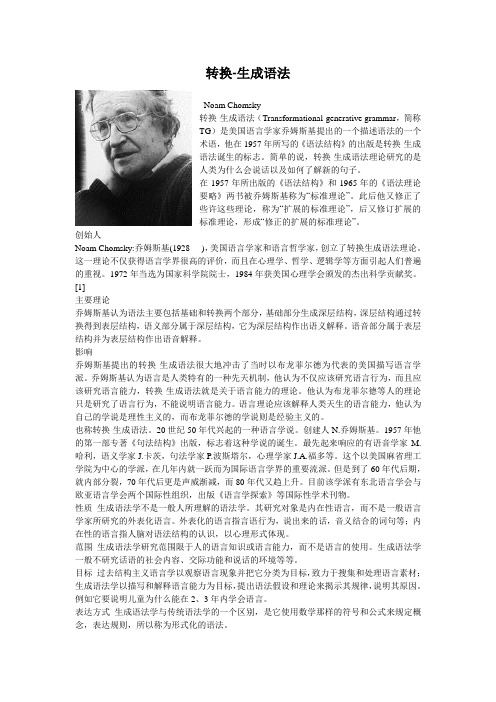
转换-生成语法Noam Chomsky转换-生成语法(Transformational-generative grammar,简称TG)是美国语言学家乔姆斯基提出的一个描述语法的一个术语,他在1957年所写的《语法结构》的出版是转换-生成语法诞生的标志。
简单的说,转换-生成语法理论研究的是人类为什么会说话以及如何了解新的句子。
在1957年所出版的《语法结构》和1965年的《语法理论要略》两书被乔姆斯基称为“标准理论”。
此后他又修正了些许这些理论,称为“扩展的标准理论”,后又修订扩展的标准理论,形成“修正的扩展的标准理论”。
创始人Noam Chomsky:乔姆斯基(1928-),美国语言学家和语言哲学家,创立了转换生成语法理论。
这一理论不仅获得语言学界很高的评价,而且在心理学、哲学、逻辑学等方面引起人们普遍的重视。
1972年当选为国家科学院院士,1984年获美国心理学会颁发的杰出科学贡献奖。
[1]主要理论乔姆斯基认为语法主要包括基础和转换两个部分,基础部分生成深层结构,深层结构通过转换得到表层结构,语义部分属于深层结构,它为深层结构作出语义解释。
语音部分属于表层结构并为表层结构作出语音解释。
影响乔姆斯基提出的转换-生成语法很大地冲击了当时以布龙菲尔德为代表的美国描写语言学派。
乔姆斯基认为语言是人类特有的一种先天机制,他认为不仅应该研究语言行为,而且应该研究语言能力,转换-生成语法就是关于语言能力的理论。
他认为布龙菲尔德等人的理论只是研究了语言行为,不能说明语言能力。
语言理论应该解释人类天生的语言能力,他认为自己的学说是理性主义的,而布龙菲尔德的学说则是经验主义的。
也称转换-生成语法。
20世纪50年代兴起的一种语言学说。
创建人N.乔姆斯基。
1957年他的第一部专著《句法结构》出版,标志着这种学说的诞生。
最先起来响应的有语音学家M.哈利,语义学家J.卡茨,句法学家P.波斯塔尔,心理学家J.A.福多等。
转换生成语法与中菜翻译t 幻灯片

在翻译的三个阶段中,核句置换最简单,因为核句 只包含一个活动词,任何从事翻译的人,译这样的 句子应该没有问题;而第一阶段分析和第三阶段 调整最为重要。分析时要透彻理解,充分把握原 文;调整时要根据汉语的特点和行文习惯,要根据 各核句之间的时间顺序和逻辑顺序,用地道的汉 语将他们组织起来,马红军分别称之为消化和汉 化
The Chinese seemed justifiably proud of their economic achievements 原文可以分析为三个核句: (1)The Chinese made economic achievements. (K2) (2)The Chinese seemed proud of it.(K5) (3)The Chinese were justifiable. (k5)
词的语义分类: a)物体词(Entity),表示参加活动的人和物; b)活动词(Event),表示动作、过程、发生; c)抽象词(Abstract),表示物体、活动和其他 抽象概念的特征、数量和程度; d)关系词(Relational),表示其他三类词中词 与词之间的关系。
一个词划归哪个语义范畴,完全取决于特定的 上下文。奈达举例说明如下: He picked up a stone, stone是物体词; they will stone him,stone是活动词; He was stone deaf,stone是抽象词。
中式菜肴中有些菜的命名浪漫唯美,中国人可 以凭借着本国的文化底蕴,了解其内在的文化 内涵,即深层结构。 翡翠汤”---Vegetable soup,green jade soup, 凤肝鸡片---Fried slicedchicken and chicken liver, Fried sliced chicken andphoenix liver 芙蓉虾仁---Fried shrimps with eggwhite
《转换生成语法》PPT课件
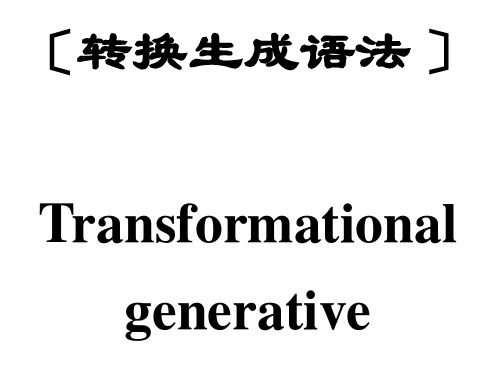
了描写的充分性这一要求〔描写出反映观察充分性的语
法是怎样生成各种语言现象的〕.
• 解释的充分性
• 如果语法描写以某种把语言学上普遍现象具体化,同时建
立语言习得理论的语言理论为依据,那么,这样的描写就涉
及到了最为复杂的解释的充分性问题.这样一种语言理论
例外均不自觉地遵从.
乔氏举儿童学习陈述句转换为疑问句的例子:
The man is tall → is the man tall?
转换似乎是分析到词,找到第一次出现的"is",
将其置于句首.乔氏又举下例:
The man who is tall is in the room.
*Is the man who ta1l is in the room?
• 针对经验主义白版论假说,主张天赋语言观.
• 针对行为主义,反对语言为刺激造成的一套习惯
的观点,反对学习论.认为:
• 人的遗传生物属性具有认知结构,其语法系统自
行发展能力和自行发展的机制,这种先天能力和
机制,为人类共有.
• 先天语言能力和自行发展机制在环境诱导下发
展,这一过程是语言习得过程.〔即语言习得离不
• 诺姆•乔姆斯基受到严格的实证主义语言
学传统的训练,即"后布龙菲尔德结构主
义"的训练. "后布龙菲尔德结构主义"统
领着20世纪40-50年代的美国语言学,乔
姆 斯 基 的 老 师 齐 里 格 • 哈 里 斯 <Zellig
Harris>就是其中最著名的代表成员.
• "后布龙菲尔德结构主义"的目标很明确,
转换生成语法PPT课件
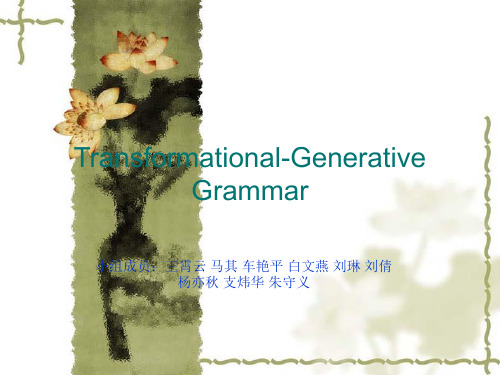
4)The Revised Extended Standard Theory (or GB), which focuses on Government and Binding Lectures on Government and Binding,1981
Hypothesis is based on sห้องสมุดไป่ตู้me important facts:
1).Children learn their native language very fast and with little effort.
2).Children learn their mother tongue in very different environments, but they follow more or less the same stages in acquisition: ①the babbling stage ②nonsense word stage ③holophrastic stage ④two-word utterance ⑤developing grammar ⑥near-adult grammar ⑦full competence
Full name Avram Noam Chomsky Born 7 December 1928 (1928-12-07) Philadelphia, Pennsylvania Era 20th/21st-century philosophy Region Western Philosophy School Linguistics, Analytic
转换生成语法

11
A generative grammar is not limited to particular languages, but to reveal the unity of particular grammars and universal grammars. It does not describe one language as an end, but as a means to explore the universal rules in the hope of revealing human cognitive systems and the essential nature of human beings.
6
Chomsky’s innateness hypothesis is based on his observations that some important facts can never be otherwise explained adequately.
乔姆斯基的天赋假设是建立在他对一些重要现象的 观察的基础之上的,这些现象无法用其他的理论解 释清楚。
12.4 Transformational Generative Grammar 转换生成语法
1.Introduction 介绍 2. Stage of development of TG grammar 转换生成语法的发展阶段 3. The Innateness Hypothesis 天赋假设
4. Generative Grammar 生成语法
乔姆斯基转换生成语法

• 合乎英语的语法,但却没有任何意义,甚至是荒 谬的。可见语法里语义是不起作用的。
语素音位规则
• 最后运用语素音位规则得出实际说出的句 子,语素音位规则的形式如下: ⅰhit+past→/hit/
• ⅱtake+past →/tuk/
• 古典理论最显著的特点之一是把语义排除在语法 之外,乔姆斯基认为,语法理论不应该建立在语 义的基础上,而应该用某种严格的、客观的方法 去代替对于模糊的语义的依赖。在《句法结构》 第2章“语法的独立性”里他举了一个著名的例子:
• ⅰS →NP+VP • ⅱNP →T+N (T:指示词,N:名词) • ⅲVP →Verb+NP • ⅳT →the • ⅴN →man ball • ⅵ Verb →hit, took • The man hit the ball.
短语结构规则
• 短语结构规则生成的是“核心语符列”, 不经过转换直接由这种语符得出的基本句 型叫“核心句”。它相当简单句、主动句、 肯定的直陈句。
短语结构规则
• 短语结构规则有三种:
• Ⅰ.合并。即把几条规则合在一起,使之简化例如:
• a, S→A
• b, S→C+D+E
• c, S→C
• d, S→A+B
• 为了简化,我们可以把(3 a-d)合并成一条规则
• S → A(B)
•
C(DE)其中{}表示可选择的成分,()
表示可有可无的成分。短语结构规则乔姆斯基 转换生成语法
• transformational generative grammar (TG)
Conversion(转换法)PPT课件

4. a big eater 饭量大的人
5. a great believer in 一个深信……的人
6. an early riser 早起的人
7. a duelist
决斗一方
8. the best hater 积怨很深的人
-
6
Conversion from English Adjectives into Chinese Verbs
• Examples: • Sugar and salt and both soluble in water.
糖和盐二者都溶于水。
The whole village was astir with the news. 消息传来,全村轰动。
-
7
Drills 4
1. She is familiar with English. 她精通英文。
-
11
Conversion from English Adverbs into Chinese Nouns
Drills 8:
1. Sodium is very active chemically. 钠的化学性质十分活泼。
2. It is officially announced that the president would visit China in May. 官方称总统会在五月访华。
-
13
(5) Subjects converted into Objects The poor were burdened with heavy taxes. 沉重的赋税压在贫苦人民的头上。 (6) Adverbials converted into Complements • Nylon is far stronger than rayon. • 尼龙比人造纤维结实得多。 (7) Objects converted into Predicative • The following provides a brief account of how
《转换生成语法》课件

提高机器翻译准确性的手段
详细描述
在机器翻译领域,转换生成语法通过对源语言和目标语言的语法规则进行建模, 能够提高机器翻译的准确性。通过构建语言规则和模型,机器可以更好地理解和 生成目标语言的句子,从而提高翻译的准确性和流畅性。
语音识别与合成中的转换生成语法
总结词
语音技术的核心算法
详细描述
在语音识别和语音合成中,转换生成语法是实现高质量语音识别和语音合成的核心算法。通过构建语音规则和模 型,语音识别系统能够将语音信号转化为文本信息,而语音合成系统则能够将文本信息转化为自然的语音输出。
CATALOG
DATE
ANALYSIS
SUMMAR Y
语义角色的识别与转换
01
语义角色是指句子中各个成分所表达的语义关系,如施事、受 事、工具等。
02
转换生成语法通过识别和转换语义角色,将深层结构的语义关
系转换为表层结构的语法关系。
语义角色的识别与转换有助于理解句子的语义信息和语法结构
03
之间的对应关系。
REPORT
CATALOG
DATE
ANALYSIS
REPORT
CATALOG
DATE
ANALYSIS
SUMMAR Y
02
转换生成语法的核心概 念
深层结构与表层结构
深层结构
句子所表达的逻辑结构和语义关系, 是抽象的句法结构。
表层结构
实际表达出来的句子形式,是具体的 语法结构。
转换规则
01
转换规则是一组语法规则,用于将深层结构转换为 表层结构。
02
转换生成语法的发展背景
20世纪50年代,美国语言学家乔姆斯基提出转换生成语法的概念,旨在克 服传统语言学中结构主义学派的局限性。
乔姆斯基转换生成语法

乔姆斯基转换生成语法一、转换生成语法的诞生及发展转换生成语法由美国学者诺姆·乔姆斯基于20 世纪50年代创建,以乔姆斯基1957 年发表的《句法结构》为标志发展至今已经有近60 年历史。
乔姆斯基的转换生成语法是语言学领域中的一次革命性变革,其影响力波及到语言学、心理学、哲学、教育学、逻辑学、计算机语言等领域,获得哲学博士学位。
1957 年乔姆斯基的博士论文缩写而成的《句法结构》在荷兰出版,奠定了转换生成语法的理论基础。
二、生成语法的研究对象的主要对象是语言能力乔姆斯基研究儿童的学习语言的过程,认识到儿童1到2岁会说简单的几个字,如:打、吃、饿,而3岁时竟然能基本学会语言中的所有词汇,他接触到的来自父母和周围环境的句子并不是很多,在这种“经验中的刺激匮乏”状态下儿童仍然能够很好的学会语言,能够理解并说出他从未听过的句子。
所以乔姆斯基认为语言的习得是人类的本能,这种说法表面上听起来很疯狂,但是我们有理由相信人类确实具备语言能力,而且这种能力是天赋的,普遍语法是“由人类所有语言所共有的原则、条件和规则组成的系统,是人类语言的本质所在。
”普遍语法主要研究语言知识能力,语言知识能力如何获得,怎样应用及其物质实现等。
他认为普遍语法1是人脑在学习语言前的初始状态,包括人类一切语言共同具有的特点。
在乔姆斯基看来,语言能力和语言运用是两个不同的概念,语言能力指的是说某种语言的人内在的具有理解和创造句子的能力,即人类语言能力。
这种能力可以说是人类与生俱来的,也是人类区别于其他动物的一个主要特征。
而语言运用只是这能力的一种体现,是人类使用某种特定语言的具体行为,也就是语言现象。
三、生成语言学在对语言结构的认识方面的新发展1.区分了“语言能力”和“语言行为”语言能力:指所有说本族语的人可以理解和说出从来没有听过或说过的句子的能力。
这里所说的能力就是掌握构成某一语言所有话语的基础的代码的能力,说话者的语言的潜在知识是人类世代相传的,天赋的。
《转换生成语言学》PPT课件

• 《句法结构》把语义排除在语法之外,这 一时期的理论框架不包括语义部分。乔姆 斯基认为,语法理论不应该建立在语义的 基础上,而应该用某种严格的、客观的方 法去代替对于模糊的语义的依赖。不过这 一理论在后来的发展中做了重大的修正。 • 《《句法结构》是转换生成语法第一阶段-古典理论的代表作,它的出版被人们认为 是"乔姆斯基革命"开始的标志,也标志着转 换生成语法的诞生
• 它以"核心句"为基础,通过转换规则描写和 分析不同句式之间的内在联系。该书分析 了以"马尔可夫过程"为基础的通讯理论,认 为它只能生成有限状态的语法,而这种"有 限状态的语法"不能生成象英语这种语言里 含有不连续结构的所有合乎语法的句子。 基于此,乔姆斯基提出了转换语法模式, 认为它才能生成所有合乎语法的句子而不 会生成不合乎语法的句子。转换语法模式 由短语结构规则、转换规则、语素音位规 则三套规则构成。
• 他把语言学看成跟自然科学中的其他科学一样,
可以从假设出发,进行推演并形式化。换句话说,
非经验主义是可能的。《句法结构》有一半篇幅
用于英语语法的形式化。非经验主义和形式化是
转换生成语法的首要标志。
• 把句法关系作为语言结构的中心并以此说明语句
的生成是这场革命的又一表现。为了描写和解释
语言现象,乔姆斯基在《句法结构》中论证了语 法的生成能力,认为应该把语法看成是能生成无 限句子的有限规则系统。
• 乔姆斯基认为语法主要包括 • 基础和转换两个部分, • 基础部分生成深层结构,深层结构通过转换得到 表层结构,语义部分属于深层结构,它为深层结
构作出语义解释。语音部分属于表层结构并为表
层结构作出语音解释。
影响
转换生成语法介绍

This That The Some A … 起 始 状 态
man bread book …
has …
this that the some …
man bread book …
brought bought eaten …
结 束 状 态
these those the some …
men books …
第一部分 生成语法观概述
壹 生成语法基本情况简介
• 转换生成语法由乔姆斯基创立、一批生 成语法的学者共同发展起来。 • 乔姆斯基是语言学家、哲学家。基本哲 学观为理性主义与行为主义的结合,采 用分析学哲方法。 • 不是为语言而研究语言(语文学、索绪 尔),而是要通过语言研究达到深刻哲 学认识、人的思维规律和心智结构的揭 示。
语法
• 它是现实世界中的实在事物,因为: • 一方面语法存在于人的大脑中,具有 物理属性; • 另一方面有具有形式上的属性,表现 为人的心智——大脑中的一个规则系 统。(引自《当代西方语法理论》171页)
普遍语法 ( UG )
• 先天的、遗传的特定结构或属性,是 人掌握语言的内在依据;
• 是人的认知系统中的一个认知结构。 体现为人类所有语言所共有的原则、 条件和规则组成的系统,是人类语言 的本质所在。
• “有限状态法”假设语言是线性地“从左自 右”生成,即第一个词规定第二个词,第二 个词限制第三个词,依次这样“总是顺着箭 头的方向来生成一个句子”。(教材 130 - 131页)
“有限状态法”的生成能力
(从左到右生成句子)
“有限状态法”即使加上封闭圈,也只能生成简单语 句,大多数符合语法的句子无法生成。许多相互依 存的单位可能被另外的一串词隔开,例如:The man who is wise is honest.” 所以,语言不是以此方法生成 的。
转换功能语法PPT
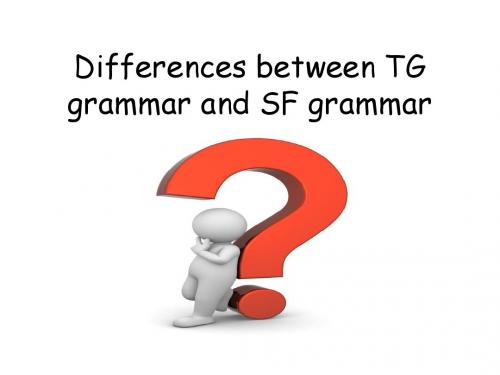
difference one
• 乔姆斯基:心灵主义论 乔姆斯基:
• Chomsky interprets children's language acquisition with the typical rationalist approach in order to explain the mystery of language acquisition at a deeper level. He believes that human’s linguistic ’ competence can not be totally obtained from the external environment, that language is a manifestation of the human mind, and that linguistic competence, through biological genes, innately exists in the healthy individual brain.
Halliday:功能论 功能论
• Halliday studies children's language development from a functional perspective. He proposed metalanguage (metalanguage) and believed that what children master first is the meta-language, by which they express their needs. Then, as children grow, they gradually learn the language’s meaning system in their social environment, and learn to use language to do things and meet their own requirements, and thus develop into social beings. Halliday holds that children's language development is actually the gradual control of the language features. "Learning their mother tongue is learning language use and its associated meanings or meaning potentials. Constructions, words and phonetics are the realization of such meaning potentials. Learning a language is learning how to express meaning."
- 1、下载文档前请自行甄别文档内容的完整性,平台不提供额外的编辑、内容补充、找答案等附加服务。
- 2、"仅部分预览"的文档,不可在线预览部分如存在完整性等问题,可反馈申请退款(可完整预览的文档不适用该条件!)。
- 3、如文档侵犯您的权益,请联系客服反馈,我们会尽快为您处理(人工客服工作时间:9:00-18:30)。
3.Five stages of development
1) The Classical Theory, which aims to make linguistics a science. Syntactic Structures,1975 2)The Standard Theory, which deals with how semantics should be studied in a linguistic theory Aspects of the Theory of Syntax,1965 3)The Extended Standard Theory, which focuses discussion on language universals and universal grammar Studies on Semantic in Generative Grammar,1972 4)The Revised Extended Standard Theory (or GB), which focuses on Government and Binding Lectures on Government and Binding,1981 5)The Minimalist Program, which is a further revision of the previous theory. The Minimal Program,1995 Minimalist Inquiries: The Framework,1998
4)What is a generative grammar? ①By a generative grammar, Chomsky simply means
“a system of rules that in some explicit and welldefined way assigns structural descriptions to sentences”. He believes that every speaker of a language has mastered and internalized a generative grammar that expresses his knowledge of his language. “Thus a generative grammar attempts to specify what the speaker actually knows, not what he may report about his knowledge.” (Chomsky, 1965) ②To generate is to predict what could be the possible sentences of language. ③Transformation is a kind of process that transforms one sentence into another. It uses a finite number of rules to produce infinite number of sentences.
ⅡThe Classical
Theory and the Standard Theory
1.How to begin the study of Language Universal?
1)Chomsky believes that every speaker of language has mastered and internalized a generative grammar that expresses his knowledge of his language. And the generative grammar, means “a system of rules that in some explicit and well-defined way assigns structural descriptions to sentences ”. 2)In order to reach his ultimate goal, Chomsky puts forward three different levels to evaluate grammars on: ①the observational adequacy level ②the descriptive adequacy level ③the explanatory adequacy 3)Contrary to Bloomfield’s data-oriented discovery procedure, Chomsky insists on the Hypothesis-deduction method and his research is called evaluation process
2.The classical Theory
1)It aims to make linguistics a science: 2)Its features: ①emphasis on generative ability of language ② introduction of transformational rules ③grammatical description regardless of meaning 3)Chomsky put forward three kinds of grammar: ①finite state grammar ②phrase structure grammar ③transformational grammar
4.The Innateness Hypothesis ( Why should there be a TG Grammar?)
When as a student of Hebrew with the structuralist methodology, he found that the classification of structural elements of language according to distribution and substitution had its limitation……he believes that language is somewhat innate, and that children are born with what he calls a Language Acquisition Device, which is a unique kind of knowledge that fits them for language learning ......According to him, the study of language, or the structure of language, can throw some light on the nature of the human mind.
Hypothesis is based on some important facts: 1).Children learn their native language very fast and with little effort. 2).Children learn their mother tongue in very different environments, but they follow more or less the same stages in acquisition: ①the babbling stage ②nonsense word stage ③holophrastic stage ④two-word utterance ⑤developing grammar ⑥near-adult grammar ⑦full competence
Main interests Linguistics ·Psychology ·Philosophy of language · Philosophy of mind ·Politics ·Ethics Notable ideas Generative grammar, universal grammar, transformational grammar, government and binding, X-bar theory, Chomsky hierarchy, context-free grammar, principles and parameters, the minimalist program, language acquisition device, poverty of the stimulus, Chomsky-Schützenberger theorem, Chomsky
Transformational-Generative Grammar
ⅠThe Birth of TG Grammar And the Innateness Hypothesis
1.Founder:American linguist Noam Chomsky
Full name Avram Noam Chomsky Born 7 December 1928 (1928-12-07) Philadelphia, Pennsylvania Era 20th/21st-century philosophy Region Western Philosophy School Linguistics, Analytic
Normal Form, propaganda model
2.The mark of the beginning
The publication of Syntactic Structures in 1957 In Syntactic Structures, Chomsky tries to construct a "formalized theory of linguistic structure" and places emphasis on "rigorous formulations" and "precisely constructed models".
